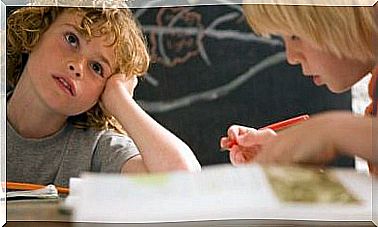Ideas For Working On Coexistence In The Classroom

When students are in class, they learn the contents of the subjects but, at the same time, they learn a lot of other knowledge. Because in the classroom you also learn attitudes, ways of relating, communicating and sharing, that is, you learn to live together. For this reason, some ideas may be useful for teachers, who, while teaching the contents of the subjects, plan activities to work coexistence in the classroom.
Coexistence in the classroom
Generating a good atmosphere of coexistence in the classroom is essential, since the characteristics adopted by coexistence within the classroom can influence both positively and negatively on student learning. To achieve a pleasant climate in the classroom, teachers must take into account that different social, cultural and emotional aspects are involved, and that all of them influence the proper development of students.
In the classroom, appropriate behaviors must be taught and learned so that children and young people can, in the future, function and coexist in society. With which, although it is a complex task, it is very important to ensure that within the classroom a calm, peaceful and harmonious space and climate is generated, where respect, tolerance and companionship prevail.
In this sense, the more ideas to work on living together in the classroom, the better. Whether through songs and games, role plays, proper use of space, or different dynamics, activities can be designed in which the primary objective is to learn to live together.
Because learning to live together is taught in an experiential way, through experiences and the possibility of being able to put oneself in the place of the other.
Ideas to work on coexistence in the classroom
Next, we propose some strategies and activities to work coexistence within the classroom designed for primary and secondary school children.

Helping a partner
In any school classroom there is a student who is more shy or more withdrawn, and when it comes to doing activities that require more socializing or speaking in public, they do not feel comfortable. Therefore, from time to time, it is important to carry out discussion activities in the face of a problematic situation.
For example: What can we do for the rest of the class when a classmate is more shy and sometimes, for example, if we have to read aloud, stutters out loud?
The idea is that students can debate and exchange ideas about whether it is okay for someone to laugh or make fun of a situation like that. What the class can do to help a classmate who is more shy or has a harder time socializing or exposing himself. Or how you would feel and what each of you would do if this happened to you.
A good idea to work on coexistence in the classroom is to create the class mascot
The objective will be to create the classroom mascot. For this, each student will bring from home objects, old clothes and all that material that can be used to make the new classmate. Thus, each day, and at a specific time set aside for it, the students will give life to their new friend.
The objective is for students to learn about cooperative and team work, and to be able to resolve conflicts that may arise from the activity. Thus, the boys must agree to create the mascot, in all the steps to follow, in the distribution of tasks and times.
Likewise, they must also agree on the form of construction, the materials to be used, and decide the place where they will spend their time. In addition, they must be able, by consensus, to choose a name for the new member of the class.
Let’s write about values
The teacher can write words such as: empathy, responsibility, equality, optimism, humility, respect, companionship, justice, solidarity, gratitude on the board . Later, the students will choose one or two of the exposed words, and will make a short essay, short story, story, or poem about values.
The idea is that the students are able, by means of examples or through situations that they themselves or known people have lived, to put in a situation and talk about some of the values mentioned.

Two other good ideas to work on coexistence in the classroom
The train of words
With colored cards you can design a train with its respective wagons and stick it on a classroom wall. The idea is that the students fill the train cars with all those words that they believe describe a pleasant atmosphere of coexistence within the classroom. This activity can be carried out on specific days or when a specific situation or problem arises in the classroom related to coexistence.
We sure have a lot in common
Putting out what unites us or the things we have in common is also a good idea to work on coexistence in class. Thus, an interesting activity may be for the teacher to read statements such as the following aloud:
- “I like french fries”.
- “I love a hug from mom. “
- “I don’t like being interrupted when I speak.”
- “The lentils are delicious.”
- “Vegetables and fruit help me to grow healthy. “
- “Soccer is the most fun.”
- “Soccer is not the best sport.”
- “Learning English is very difficult, but you have to do it. “
- “I would not like to feel alone or alone.”
- “Working together helps each of us. “
- “Sometimes I can disobey.”
- “I’m not better than anyone and I don’t know everything.”
- “A candy is not bad from time to time.”
- “Any conflict between people can be fixed by talking. “
The objective of the activity is for each student to write down on a sheet of paper what they identify with, like, do or think is good so that, later, the whole class talk about the coincidences, discuss the issues and have fun.










